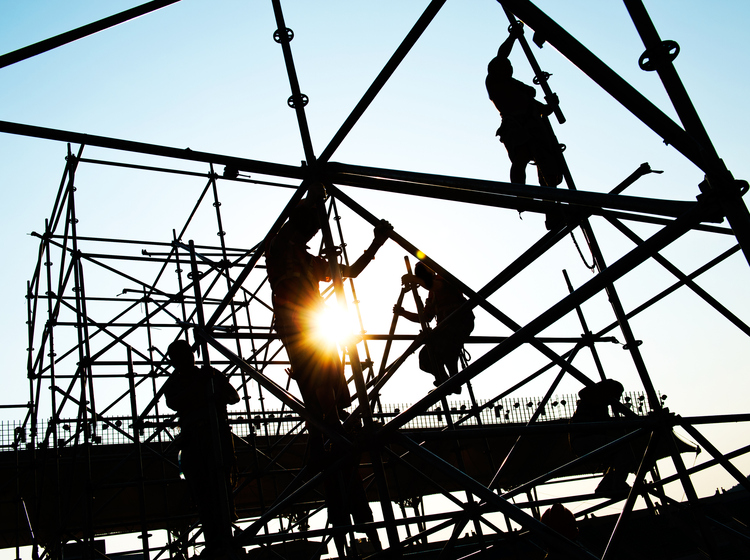Scaffolding collapses are often caused by poor construction, overloading, inadequate maintenance, or unsafe weather conditions. These failures are especially dangerous on busy construction sites, where workers rely on scaffolds to perform tasks at heights. When scaffolding isn’t built or secured properly, the risk of collapse increases. Learn the most common reasons scaffolding collapses and how workers and employers can help prevent these dangerous accidents.
At The Weinstein Law Group, our New York construction accident lawyers fight for injured workers and stay up to date on the laws that protect them. Here’s what to know about scaffolding collapses and how you may be able to recover compensation after a fall.

Key factors leading to scaffolding collapses
Scaffolding collapses are a leading cause of construction site injuries, with the Occupational Safety and Health Administration (OSHA) estimating that scaffold-related incidents injure over 4,500 workers each year in the U.S. Most of these accidents are preventable. These are the key causes of scaffold failure:
Poor construction and assembly
One of the main reasons scaffolding collapses is poor setup. Scaffolding needs to be constructed properly using approved materials and designs. When it’s put together incorrectly or missing parts, it can become unstable. This can happen when workers aren’t properly trained or rushed to finish the job. In either case, unsafe scaffolding poses a danger to everyone nearby.
Overloading
Scaffolding is designed to support a certain amount of weight. Overloading scaffolds with too many workers or too much equipment can lead to structural failure. Supervisors must enforce strict adherence to load capacities as specified by the scaffold’s design.
Inadequate maintenance
Scaffolding needs regular checks and upkeep. If parts are rusted, bent, or worn out, the entire system becomes unsafe. A weak scaffold might collapse under normal weight. That’s why daily inspections and timely repairs are so important.
Environmental factors
Bad weather can make scaffolding more dangerous. Wind may push it over, and rain or snow adds extra weight and makes it slippery. If it’s not properly secured, the structure can fail. That’s why OSHA requires scaffolds to be inspected after storms or severe conditions before work resumes.
Legal and safety regulations in New York
Both federal and state regulations govern scaffolding safety, but New York takes things a step further with one of the strongest worker protection laws in the country: the New York State Scaffold Law, also known as Labor Law Section 240.
This law requires contractors, property owners, and their agents to provide proper scaffolds, ladders, hoists, ropes, and other equipment to prevent gravity-related injuries. If that equipment fails or isn’t used safely, and a worker is hurt as a result, the employer or property owner can be held strictly liable, even if the worker contributed to the accident.
Unlike most injury claims, injured workers don’t have to prove negligence under the Scaffold Law. This absolute liability standard helps make sure that construction workers can recover compensation for serious falls or injuries caused by falling objects.
Why injured workers trust The Weinstein Law Group
At The Weinstein Law Group, we understand the devastating impact of construction accidents, both physically and financially. That’s why we treat every client like a person, not a case file.
Founding attorney Steven Weinstein takes the time to explain your legal options in plain English, so you always know where your case stands and why each step matters.
Our team builds each construction accident lawsuit with meticulous care, starting with a detailed Medical Timeline that captures every aspect of your injury, from the initial EMT report to your latest doctor’s visit. This approach enables us to identify the most effective path forward and puts pressure on insurers to offer fair compensation. When you’re hurt, you deserve a lawyer who shows up and fights for you.
Preventive measures to avoid scaffolding collapses
Preventing a collapse starts before a worker ever steps onto a scaffold. These steps help reduce the risk of an accident.
Regular training and inspections
OSHA requires safety training for anyone who works on or builds scaffolding. Workers must know how to use it safely and spot warning signs of trouble. Daily inspections help catch broken or unsafe parts before someone gets hurt. Scaffolds include suspended scaffolds, supported scaffolds, and aerial lifts, each with its own requirements under OSHA safety guidelines.
Engaging expert legal counsel
For construction companies, staying compliant with scaffolding regulations is not just about avoiding fines but protecting workers. The Weinstein Law Group specializes in construction law and can help companies implement compliance measures that adhere to federal and state safety standards. We provide expert legal representation for workers injured in scaffolding collapses and make sure they receive the compensation they deserve.
Get legal help after a scaffolding collapse in New York
Scaffolding accidents can result in life-altering injuries for workers. If the collapse was due to poor setup, adverse weather conditions, lack of maintenance, or other factors, you have legal options. With the right legal team, you can hold the responsible parties accountable and get the financial support you need to heal.
For those affected by scaffolding accidents or for firms seeking to enhance their safety practices, The Weinstein Law Group stands ready to provide expert advice and robust representation to navigate the complexities of New York’s construction safety laws. Call The Weinstein Law Group at (212) 741-3800 or contact us online for a free consultation today.
